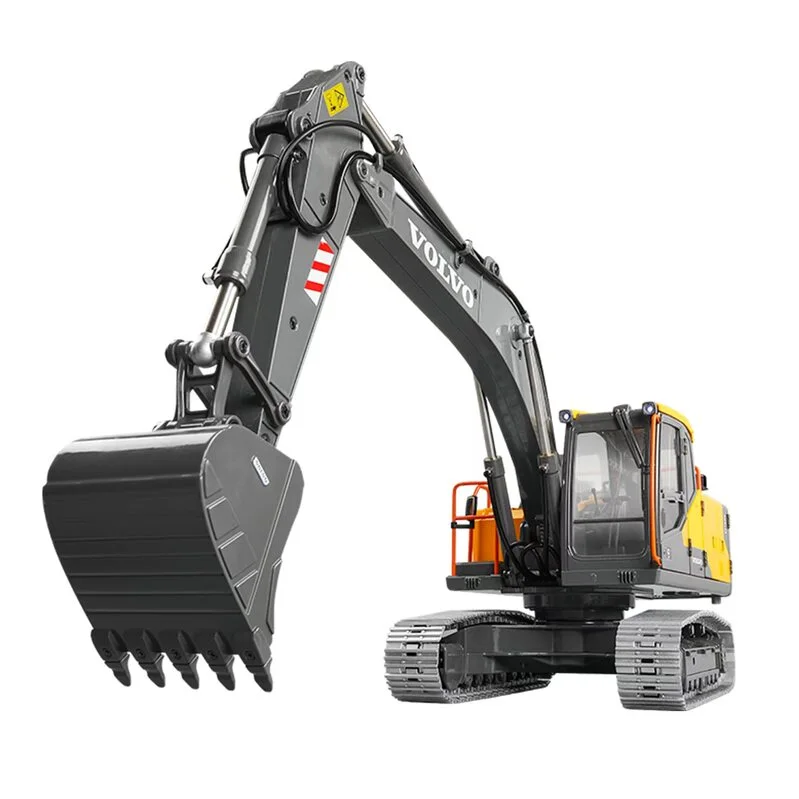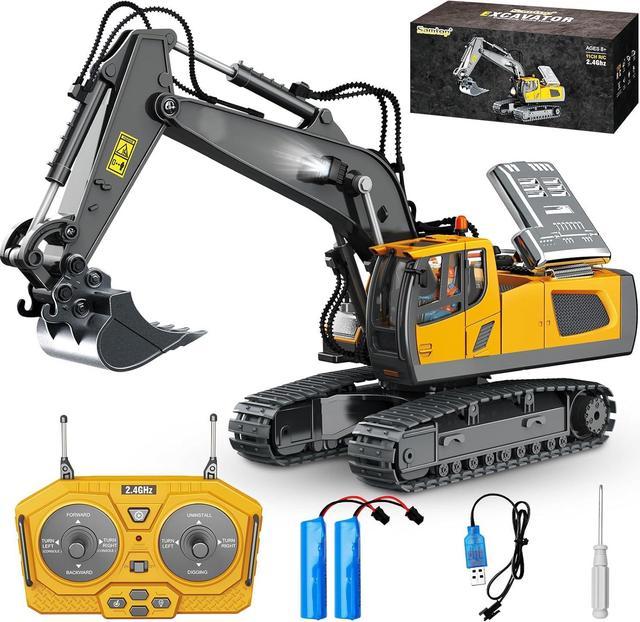The Necessary Features of Excavator That Make It a Must-Have Device
Excavators are indispensable in the building and landscaping markets. Their flexible add-ons permit a variety of jobs, from digging to demolition. Furthermore, they flaunt exceptional excavating depth and reach, powered by durable engines. Driver convenience and compact layouts improve usability in numerous settings. What absolutely sets excavators apart are their sophisticated hydraulic systems and longevity. Understanding these attributes can make clear why they are taken into consideration crucial devices on any work site.
Flexible Accessories for Boosted Performance
Excavators are effective makers on their own, the addition of functional attachments considerably boosts their capability. These accessories change a common excavator right into a multi-purpose tool, appropriate for a selection of tasks. Pails, for instance, can be found in various sizes and shapes, allowing drivers to dig, scoop, and relocate products effectively. Hydraulic thumbs can be included for boosted gripping and handling of large products, such as logs or rocks.Furthermore, specialized attachments like breakers and augers enable for exploration and demolition work, broadening the excavator's utility on construction sites. remote control excavator. Grapples are another alternative, perfect for moving and arranging debris. This flexibility not only raises efficiency however also decreases the need for several makers, saving time and costs. By gearing up excavators with the ideal accessories, drivers can deal with varied projects, making them important in the building and construction market
Superior Digging Deepness and Reach
Excavators are developed with exceptional digging deepness and reach, enabling them to navigate in limited areas and access hard-to-reach areas. This capability is important for various construction and excavation jobs, where conventional machinery may drop brief. With flexible boom arms and extendable tracks, excavators can quickly browse unequal surface while preserving stability.The digging deepness can differ substantially among models, commonly varying from 10 to 25 feet, relying on the design and objective. This attribute makes it possible for drivers to dig deep into foundations, trenches, and various other deep structures efficiently. In addition, the reach of an excavator enables precise digging and product handling without rearranging the maker regularly, saving time and labor costs.Ultimately, the remarkable excavating depth and reach of excavators make them crucial for specialists seeking to finish complicated tasks with precision and efficiency. Their convenience boosts efficiency on work sites, showcasing them as an essential device in contemporary building and construction.
Powerful Engine Performance

Powerful engine performance plays an essential function in the abilities of an excavator when it comes to effectiveness and productivity on building and construction websites. A durable engine generates substantial horsepower, permitting the machine to tackle sturdy jobs with simplicity - remote control excavator. This toughness converts into faster cycle times, making it possible for operators to total jobs much more quickly.Additionally, powerful engines give the required torque to handle difficult surfaces and varied loads, ensuring that the excavator can execute efficiently under different conditions. Whether it is lifting, digging, or moving materials, the engine's performance directly affects the general functional performance of the machine.Furthermore, improvements in engine technology have caused enhanced fuel effectiveness, minimizing operational prices while maintaining power outcome. Eventually, the engine's performance acts as the foundation of an excavator, affirming its status as an essential device in the building industry
Advanced Hydraulic Systems

Boosted Lifting Capability
A substantial improvement in lifting capability can be associated to innovative hydraulic systems found in modern excavators. These systems utilize high-pressure fluid to create greater pressure, enabling operators to raise larger lots with ease. The engineering behind these hydraulics assurances peak performance, providing a remarkable power-to-weight proportion that boosts overall performance. Consequently, excavators can tackle requiring tasks, such as lifting big materials or equipment, without endangering stability. Additionally, the durable layout of hydraulic parts contributes to boosted sturdiness and dependability, making them appropriate for different building settings. This enhanced lifting capacity not just minimizes the time required for jobs but likewise reduces the requirement for additional machinery, confirming necessary for both efficiency and cost-effectiveness in the building and construction market.
Enhanced Precision Control
Typical excavators often battled with accuracy, modern hydraulic systems have actually transformed control systems, enabling operators to carry out jobs with impressive accuracy. These sophisticated systems utilize proportional control valves that permit smoother and much more responsive movements, considerably minimizing the margin for mistake. Operators can now finely tune the excavator's motions, making it easier to browse tight rooms and deal with fragile materials. Enhanced responses systems even more educate operators of real-time efficiency, making sure perfect control between the machine and operator. This increased precision not only enhances effectiveness however likewise enhances security on work sites, minimizing the risk of accidents. Consequently, modern excavators furnished with sophisticated hydraulic systems are very useful devices for construction and excavation jobs requiring precise accuracy.
Operator Convenience and Visibility
Operator comfort and presence are vital elements in the style of modern excavators (remote control excavator). Features such as ergonomic seat style, improved visibility alternatives, and reliable control formats significantly boost the operator's experience and performance. Prioritizing these facets assurances that operators can work successfully and safely in different problems
Ergonomic Seat Design
Comfort and presence are critical in excavator layout, with the ergonomic seat playing an essential duty in improving the operator's experience. An ergonomic seat is crafted to support the operator's body, minimizing tiredness during lengthy hours of operation. Flexible attributes, such as seat height, backrest angle, and lumbar assistance, satisfy specific choices and advertise excellent pose. These adjustments improve comfort and make it possible for the operator to maintain concentrate on tasks without discomfort. In addition, a properly designed seat can supply much better side assistance, permitting smoother maneuvering when the excavator functions. This thoughtful style not only boosts efficiency but likewise adds to total security, making sure that operators can execute their duties efficiently and successfully.
Improved Exposure Attributes
The style of an excavator extends past just the seat, with enhanced presence functions playing a substantial function in driver convenience and overall security. Large home windows and purposefully located mirrors offer operators with a clear sight of their surroundings, reducing blind spots. This design consideration enables for far better spatial recognition, try this site which is vital in active workplace. In addition, numerous excavators include rearview electronic cameras and advanced surveillance systems that help drivers in steering tight spaces. The integration of these presence features not just advertises safety however also lowers operator tiredness by enabling less complicated tracking of workplace. Inevitably, boosted presence adds to much more efficient operations and aids assure that excavators can perform their jobs efficiently and safely.
Control Layout Performance
While handling complicated work sites, an effective control design greatly improves both operator convenience and visibility. A properly designed control arrangement guarantees that operators can access important features with very little initiative, reducing tiredness during long hours. Ergonomic joystick placements and intuitive button plans permit smooth operation, enabling operators to maintain concentrate on the task at hand. In addition, clear exposure of both the workspace and the control panel is vital for security and precision. Modern excavators commonly integrate adjustable seating and control setups to fit various operator preferences, additionally improving comfort. Inevitably, a thoughtfully made control design not just boosts performance however also promotes a more secure working setting by enabling drivers to react quickly to changing problems.
Compact Design for Urban Environments
As city building and construction sites typically encounter room restrictions, a portable layout becomes vital for excavators operating in these atmospheres. These machines are engineered to browse limited rooms, enabling effective ability to move in congested task websites. A reduced impact allows them to work closely to existing frameworks, decreasing interruption and taking full advantage of productivity.The small design commonly consists of much shorter tracks and a tighter turning span, facilitating operation in slim streets and constrained locations. Light-weight materials add to relieve of transport, making it less complex to relocate the excavator from one place to another within the metropolitan landscape.Additionally, numerous compact excavators are outfitted with functions such as extendable arms and functional accessories, visit this web-site improving their performance while maintaining a tiny dimension. This versatility enables drivers to deal with a variety of jobs, from digging to demolition, all while suitable flawlessly right into the constraints of urban settings.

Toughness and Maintenance Considerations
Longevity stands as a crucial variable in the performance and long life of excavators, particularly in demanding city settings. These makers go through extensive conditions, including varying soil kinds, extreme temperature levels, and high-frequency use. Top quality materials and robust building and construction are required for ensuring that excavators can endure these obstacles without endangering functionality.Regular upkeep is just as vital in preserving longevity. Scheduled inspections, timely oil adjustments, and the replacement of worn parts add significantly to an excavator's lifespan. Operators has to likewise take notice of hydraulic systems, tracks, and undercarriages, as these components usually bear the force of wear and tear.Investing in long lasting excavators with comprehensive maintenance plans boosts reliability and minimizes downtime, eventually causing increased productivity on construction sites. Consequently, comprehending the interplay between longevity and maintenance is important for anyone taking into consideration the purchase of an excavator for metropolitan tasks.
Often Asked Inquiries
Just How Do Excavators Contrast to Various Other Construction Tools?
Excavators attract attention among building equipment because of their adaptability, making it possible for tasks such as excavating, training, and grading. Compared to others, their hydraulic capacities provide greater performance and power, making them indispensable on various work sites.
What Safety And Security Includes Are Consisted Of in Modern Excavators?
Modern excavators incorporate various safety and security features, including rollover defense systems, alarm systems, and advanced presence enhancements. These components interact to decrease threats, making certain operator safety while improving performance on building and construction sites and various other requiring atmospheres.

Can Excavators Be Made Use Of in Winter Conditions?
Excavators can certainly be made use of in wintertime problems, supplied they are equipped with suitable winter season accessories and precautions are taken. Appropriate upkeep and modifications improve their performance, making sure reliable procedure regardless of tough weather condition conditions.
What Is the Typical Life Expectancy of an Excavator?
The typical life-span of an excavator normally ranges from 7,000 to 10,000 hours of procedure. This period can greatly rely on maintenance practices, running conditions, and the certain design's sturdiness and layout attributes.
How Do I Select the Right Excavator Dimension for My Job?
Choosing the best excavator dimension involves evaluating project range, site problems, and product types. Take into consideration aspects like reach, deepness requirements, and weight capability to guarantee optimal performance and security throughout procedure. Size issues considerably in job success. Furthermore, the reach of an excavator enables for exact excavating and material handling without rearranging the device often, conserving time and labor costs.Ultimately, the premium digging deepness and reach of excavators make them indispensable for professionals looking for to complete complex tasks with precision and efficiency. Comfort and visibility are vital in excavator style, with the ergonomic here are the findings seat playing an important duty in boosting the driver's experience. The layout of an excavator expands beyond simply the seat, with improved presence functions playing a significant duty in operator convenience and general security. Modern excavators frequently include adjustable seating and control setups to accommodate numerous driver choices, better boosting convenience. Lightweight materials add to alleviate of transportation, making it less complex to move the excavator from one area to one more within the metropolitan landscape.Additionally, lots of compact excavators are furnished with attributes such as flexible attachments and extendable arms, enhancing their capability while preserving a small size.